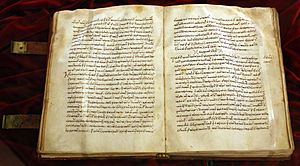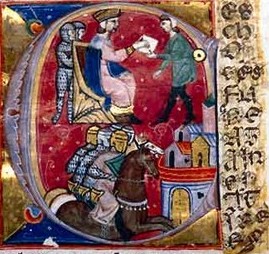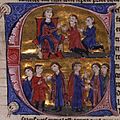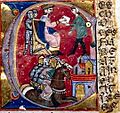Alexiad facts for kids
The Alexiad (pronounced Ah-lex-EE-as) is an important historical book written around the year 1148. It was penned by a Byzantine princess named Anna Komnene. She was the daughter of Alexios I Komnenos, who was the emperor of the Byzantine Empire.
Anna wrote the Alexiad to tell the story of her father's reign. It covers the political and military events of the Byzantine Empire during his time. The book is a valuable source for understanding the High Middle Ages from a Byzantine point of view. It also describes how the Byzantine Empire interacted with the Crusades. The Alexiad shows the different ways people in the East and West saw each other in the early 12th century.
Contents
What is the Alexiad About?
The Alexiad is divided into 15 parts, called "books," plus an introduction. It focuses only on the time Alexios I was emperor. This allowed Anna to describe events in great detail. She especially focused on the relationships between the Byzantine Empire and countries in Western Europe.
Conflicts and Challenges
The book covers many challenges faced by the Byzantine Empire:
- Battles with the Normans: These were fierce attacks led by Robert Guiscard against the empire.
- Dealing with the Turks: The book describes the empire's ongoing struggles and relationships with various Turkish groups.
- Pecheneg Invasions: It also tells about attacks from the Pechenegs, a nomadic group, on the northern borders.
- The First Crusade: A major part of the book describes the arrival of the First Crusade and how the Byzantines reacted to it.
- More Norman Attacks: The book also covers later attacks by Bohemond I of Antioch, Robert Guiscard's son.
Was the Author Biased?
Anna Komnene said she wanted to write down true events. However, her book does show some bias. She often presented her father, Alexios, as a great Christian emperor. She showed him as a good and moral leader.
Anna also described Western Europeans, like the Normans and "Franks" (Crusaders), as "barbarians." She also showed dislike for the Turks and Armenians. The Alexiad also criticized her brother, John II Komnenos. She believed she should have become empress instead of him after her father died.
Even with these strong opinions, the Alexiad is still very important. Historians see it as a key document from that time. It gives us a firsthand look at the Byzantine Empire.
Main Ideas in the Alexiad
The main topic of the Alexiad is the First Crusade and the religious conflicts of that time. Anna Komnene wrote about the different groups involved in the Crusades. She called them "Celts," "Latins," and "Normans."
She also wrote a lot about her father, Alexios Komnenos. She described his achievements during his rule from 1081 to 1118. She presented a "Byzantine view" of the Crusades. Some historians have also noticed that her writing was influenced by Greek mythology. For example, she sometimes described Alexios as a clever sea captain. This character reminds readers of Odysseus, a hero from ancient Greek stories.
Anna's Unique Writing Style
The Alexiad was originally written in Greek around 1148. Anna Komnene often included her own feelings and opinions in the text. This was unusual for historians at that time. Most historians tried to be completely objective.
Because of her unique style, the book was first well-received. Later, some people criticized it. Historians today find the Alexiad interesting because Anna wrote it differently from the usual style. Anna Komnene is the only female Greek historian from her era. Many historians believe her writing style was influenced by her being a woman.
Who Wrote the Alexiad?
Debate About the Author
There has been some discussion about whether Anna Komnene truly wrote the Alexiad herself. One scholar suggested that the text doesn't give many clues about the author's gender. This led some to wonder if a man might have written it. This idea mainly focused on the military parts of the book. It suggested Anna might have used her husband's notes.
However, most scholars agree that Anna Komnene was indeed the author. The book mentions her engagement and her role as a wife. It also talks about her female modesty influencing her writing. These details make her authorship "unmistakable" to many. She could certainly write about military matters. She often went with her father, the emperor, on his military trips. Many scholars believe the detailed descriptions of her father's home life and military style, along with her personal experiences, strongly support her being the author.
How Gender is Shown
In the Alexiad, Anna Komnene shows gender and gender stereotypes in an interesting way. Like male writers of her time, she sometimes described women as being "liable to tears and as cowardly in the face of danger." However, women in the Alexiad rarely cry. The only exception is at Alexios's funeral, where sadness was expected. Also, none of the female characters act in a cowardly way.
Anna herself mentions crying while writing about certain events. But she quickly says she will stop crying to focus on her duty as a historian. She repeats this twice. This shows her desire to control aspects that were seen as feminine in her culture. Overall, Anna cared most about intelligence, which she saw in both men and women. She allowed women in her book to break free from typical societal gender roles.
Complete Manuscripts
Here are some of the main copies of the Alexiad that still exist:
- Codex Coislinianus 311, in Fonds Coislin (Paris)
- Codex Florentinus 70,2
- Codex Vaticanus Graecus 1438
- Codex Barberinianus 235 & 236
- Codex Ottobonianus Graecus 131 & 137
- Codex Apographum Gronovii
- Codex Vaticanus Graecus 981 (prologue and summary)
- Codex Monacensis Graecus 355 (prologue and summary)
- Codex Parisinus Graecus 400 (prologue and summary)
Images for kids
See also
 In Spanish: Alexiada para niños
In Spanish: Alexiada para niños







